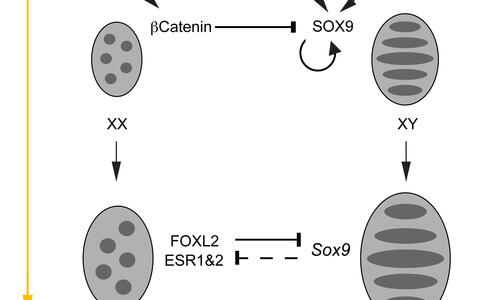
Sexual reproduction
During initial phases of sex determination, SRY up-regulates SOX9 expression, and subsequent positive autoregulatory loops involving SOX9 itself. Together with FGF9 and prostaglandin D2 signaling, this activates and maintains Sox9 expression in male gonads, whereas ß-catenin, stabilized by WNT4 and RSPO1 signaling, suppresses SOX9 expression in female gonads.
After birth ß-catenin activity declines and thus in adult female gonads, FOXL2 and estrogen receptors are required to actively repress SOX9 expression to ensure female somatic cell fate.
The transcriptional repression of SOX9 by FOXL2 and estrogen receptors is necessary throughout the lifetime of the female to prevent transdifferentiation of the somatic compartment of the ovary into a testis.
Interaction of FOXL2 and SOX9 (click on the figure)
XX = girl and XY = boy
That's what we learnt in school, right? However, there is more to gender phenotype than meets the eye.
We have recently uncovered the molecular mechanism underlying sexual maintenance in mammals revealing an unexpected and fascinating plasticity through a Yin and Yang relationship between two genes, whose expression is mutually exclusive. These two genes are called FOXL2 and SOX9, both transcriptional regulators.
While SOX9 protein expression is abundant in males at all stages of development, it has to be continuously suppressed in adult females to stabilize the female phenotype and to prevent trans-differentiation of the ovaries into testes (see Uhlenhaut et al, Cell 2009).

